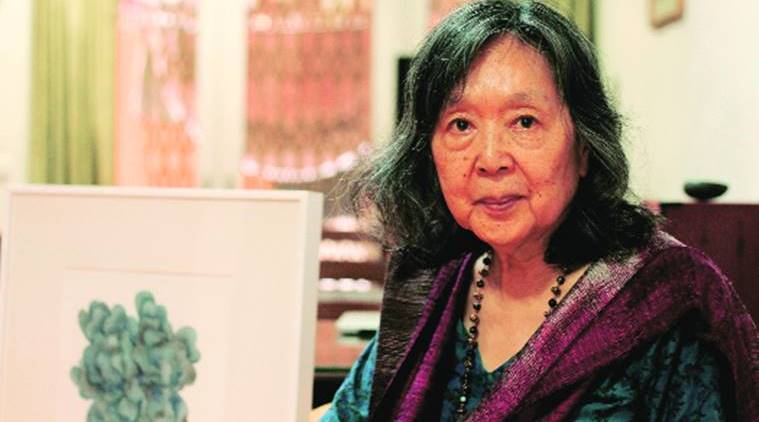 Ramachandran, who did her Master’s in ancient Indian history and culture from Viswa Bharati University, was in her 50s when she made her solo debut at Habitat Art Gallery in Delhi in 1993.
Ramachandran, who did her Master’s in ancient Indian history and culture from Viswa Bharati University, was in her 50s when she made her solo debut at Habitat Art Gallery in Delhi in 1993.
When Chameli Ramachandran was around 10, she recalls being invited by Ramkinkar Baij to model for him while he taught watercolour painting to his students in Kala Bhavan. Growing up in Santiniketan — where her father, the Chinese scholar Tan Yun-Shan, was a teacher — Ramachandran would often see the master sculptor at work. She remembers watching Baij intently as he worked on his monumental sculpture Mill Call (1956) or when took his students for long walks to sketch the Santhals who lived nearby. “As a teenager, I used to go to Baij to show him my work. He was too senior and I was too young but he was always encouraging and friendly, a bit eccentric at times,” she recalls.
The artist is surrounded by paintings, all the labour of the last three years when we meet at Vadehra Art Gallery. Her ink and wash appear as intimate studies of shrubs and flowers. Her oeuvre is largely influenced by her proximity to nature. “I don’t remember when I started painting nature. It came naturally to me. We grew up in nature. I would look at my own garden, study the flowers and that has continued,” says Ramachandran, 78, pointing out that in the current exhibition, “Home and Beyond”, the land lotus, cockscomb and Champa flowers belong to her Preet Vihar home in Delhi. The coconut palms and lotuses are ubiquitous in husband A Ramachandran’s native Thiruvananthapuram and the coniferous trees and snow-capped mountains are part of the landscape near her son’s North American home. “We always carry art material during our annual trip to the US, every winter,” she adds. Last year, apart from paintings, she returned with dried flowers that feature in the ongoing exhibition.
Ramachandran, who did her Master’s in ancient Indian history and culture from Viswa Bharati University, was in her 50s when she made her solo debut at Habitat Art Gallery in Delhi in 1993. Till then, she was occupied in being a mother to two children. The only outlet that showcased her artistic talent was the books she illustrated with A Ramachandran. “He would make the composition and I worked on the cuttings,” she says. Together, the couple published several illustrated books, telling tales of Dakiya the mailman, Bhima from the Mahabharata, and the bad king who became a good king. “These were stories we narrated to our children, and we published the ones they enjoyed,” says Ramachandran.
Her childhood was spent in the vast open greens of Santiniketan. On the invitation of Rabindranath Tagore, her father moved to India from China in 1928 to establish a centre for Chinese studies. “My father loved India and adored Tagore. He gave up his comfortable life in Singapore and even made my mother give up her job as the principal of a school in Malaysia to settle for a simple life in Santiniketan,” says Ramachandran. Fifth of the couple’s seven children and the first to be born at Santiniketan, she was named by Tagore after the fragrant jasmine flower. Ranesh Ray writes in his book, A Confluence of Distilled Essences/The Art of Chameli Ramachandran (2008), that the name was also an amalgam of three syllables which Tagore felt had a distinct Chinese sound.
“We had people from all over the world in Santiniketan. It was a very different atmosphere. Now the university has expanded and the original character is totally lost” says Ramachandran. As a child, she remembers being captivated by the open air classes in the campus. “My father would make us sit in the verandah at our house to watch the sky. He wanted us to realise the vastness of the universe and expand our vision.” Watching him grind ink and practise calligraphy are life lessons that little Chameli never forgot.
“One of the remarkable features about her work is the blend of Chinese calligraphy and Indian subjects. She likes to capture the fluidity in nature’s movement and her control over the brush and flow of ink on paper is remarkable,” says art historian Ella Datta. While her earlier work was in monochromes, later Ramachandran added metallic hues for sheen. Till recently, she would also laboriously grind tablets to prepare ink, till scoliosis restricted her physical movement. The exacting technique, Ramachandran says, does not permit any errors but is one she finds most pleasing. “It can’t be rubbed or drawn over but it’s still something I like. I end up wasting a lot of paper though,” says Ramachandran, laughing.
Among her most cherished works is still the one Baij gifted her when she was 10. “I did not like it much but I kept it. Now I realise how, in a few strokes, he could depict the character of my face,” she says.